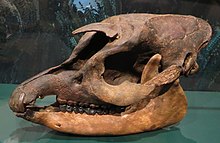| Tapirus haysii Temporal range:
Early Pleistocene–
Middle Pleistocene
| |
|---|---|

| |
| A Copes' tapir skull held at the Natural History Museum in Karlsruhe, Germany | |
|
Scientific classification
| |
| Domain: | Eukaryota |
| Kingdom: | Animalia |
| Phylum: | Chordata |
| Class: | Mammalia |
| Order: | Perissodactyla |
| Family: | Tapiridae |
| Genus: | Tapirus |
| Species: | †T. haysii
|
| Binomial name | |
| †Tapirus haysii Leidy 1859
[1]
| |
| Synonyms | |
| |
Tapirus haysii, commonly known as Cope's tapir, [3] is an extinct species of tapir that inhabited North America during the early to middle Pleistocene Epoch (~2.5–1 Ma). [1] The fossil remains of two juvenile T. haysii were collected in Hillsborough County, Florida on August 31, 1963. [2] It was the second largest North American tapir; the first being T. merriami. [4]
Taxonomy
Taprirus haysii is placed in the subgenus Helicotapirus, which also includes Tapirus veroensis and Tapirus lundeliusi. [5]
References
- ^ a b "Tapirus haysii". Florida Museum of Natural History. Retrieved 12 March 2017.
- ^ a b "Tapirus copei Simpson | Collections Search Center, Smithsonian Institution".
- ^ "Tapirus copei Simpson, 1945: Cope's tapir". The Recently Extinct Plants and Animals Database. Retrieved 25 June 2024.
- ^ Kurtén, Björn. Pleistocene Mammals of North America. Columbia University Press. p. 293. ISBN 0231516967.
- ^ Hulbert, Richard Jr. (30 September 2010). "A new early Pleistocene tapir (Mammalia: Perissodactyla) from Florida, with a review of Blancan tapirs from the state" (PDF). Bulletin of the Florida Museum of Natural History. 49 (3): 67–126. doi: 10.58782/flmnh.ezjr9001.